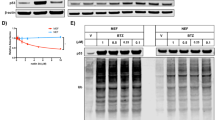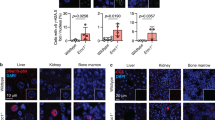Abstract
We report the cloning and characterization of a novel p53 and DNA damage-regulated gene (PDRG). The human and mouse PDRG sequences are highly homologous and contain open reading frames of 133 amino acids each with molecular masses of 15.5 and 15.3 kDa, respectively. PDRG codes for a novel protein that does not show similarity to any known protein in the databases. Human PDRG is predominantly expressed in normal testis and exhibits reduced but detectable expression in other organs. GFP-tagged PDRG was predominantly detected as aggregates that appeared to reside in a distinct subcellular compartment. PDRG mRNA was upregulated by ultraviolet radiation (UV) but downregulated by tumor suppressor p53. UV is known to transcriptionally upregulate the expression of certain genes by activating the transcription factor Oct-1, while p53 has been reported to suppress transcription of certain genes by directly binding to a novel head-to-tail response element. Cloning and sequence analysis of PDRG promoter revealed the presence of Oct-1-binding element and a putative head-to-tail-type p53-binding site. Indeed, UV as well as exogenous Oct-1 independently increased PDRG promoter activity, suggesting that UV could mediate PDRG upregulation via Oct-1. Exogenous wild-type p53 was found to downregulate the PDRG promoter activity indicating that wild-type p53 transcriptionally suppresses the expression of PDRG and may mediate its effect via the putative head-to-tail response element. Furthermore, stable expression of exogenous PDRG was found to decrease the clonogenic survival after UV irradiation, which highlights the significance of PDRG in facilitating UV-induced killing.
This is a preview of subscription content, access via your institution
Access options
Subscribe to this journal
Receive 50 print issues and online access
$259.00 per year
only $5.18 per issue
Buy this article
- Purchase on Springer Link
- Instant access to full article PDF
Prices may be subject to local taxes which are calculated during checkout











Similar content being viewed by others
References
Adimoolam S and Ford JM . (2002). Proc. Natl. Acad. Sci. USA, 99, 12985–12990.
Alarcon-Vargas D and Ronai Z . (2002). Carcinogenesis, 23, 541–547.
Bao S, Tibbetts RS, Brumbaugh KM, Fang Y, Richardson DA, Ali A, Chen SM, Abraham RT and Wang XF . (2001). Nature, 411, 969–974.
Bargonetti J and Manfredi JJ . (2002). Curr. Opin. Oncol., 14, 86–91.
Bulavin DV, Saito S, Hollander MC, Sakaguchi K, Anderson CW, Appella E and Fornace Jr AJ . (1999). EMBO J., 18, 6845–6854.
Buschmann T, Potapova O, Bar-Shira A, Ivanov VN, Fuchs SY, Henderson S, Fried VA, Minamoto T, Alarcon-Vargas D, Pincus MR, Gaarde WA, Holbrook NJ, Shiloh Y and Ronai Z . (2001). Mol. Cell. Biol., 21, 2743–2754.
de Laat WL, Jaspers NG and Hoeijmakers JH . (1999). Genes Dev., 13, 768–785.
Desdouets C, Ory C, Matesic G, Soussi T, Brechot C and Sobczak-Thepot J . (1996). FEBS Lett., 385, 34–38.
el-Deiry WS . (1998). Semin. Cancer Biol., 8, 345–357.
el-Deiry WS, Kern SE, Pietenpol JA, Kinzler KW and Vogelstein B . (1992). Nat. Genet., 1, 45–49.
Fontanini G, Boldrini L, Calcinai A, Chine S, Lucchi M, Mussi A, Angeletti CA, Basolo F and Bevilacqua G . (1999). Clin. Cancer Res., 5, 155–161.
Fornace Jr AJ . (1992). Annu. Rev. Genet., 26, 507–526.
Friedberg EC . (2003). Nature, 421, 436–440.
Giaccia AJ and Kastan MB . (1998). Genes Dev., 12, 2973–2983.
Gottifredi V, Karni-Schmidt O, Shieh SS and Prives C . (2001). Mol. Cell. Biol., 21, 1066–1076.
Gu W, Shi XL and Roeder RG . (1997). Nature, 387, 318–323.
Guo Z, Kumagai A, Wang SX and Dunphy WG . (2000). Genes Dev., 14, 2745–2756.
He Q, Luo X, Huang Y and Sheikh MS . (2002). Oncogene, 21, 6032–6040.
Heffernan TP, Simpson DA, Frank AR, Heinloth AN, Paules RS, Cordeiro-Stone M and Kaufmann WK . (2002). Mol. Cell. Biol., 22, 8552–8561.
Hoeijmakers JHJ . (2001). Nature, 411, 366–374.
Hoffman WH, Biade S, Zilfou JT, Chen J and Murphy M . (2002). J. Biol. Chem., 277, 3247–3257.
Huang Y, He Q, Hillman MJ, Rong R and Sheikh MS . (2001). Cancer Res., 61, 6918–6924.
Hwang BJ, Ford JM, Hanawalt PC and Chu G . (1999). Proc. Natl. Acad. Sci. USA, 96, 424–428.
Innocente SA, Abrahamson JL, Cogswell JP and Lee JM . (1999). Proc. Natl. Acad. Sci. USA, 96, 2147–2152.
Johnson RA, Ince TA and Scotto KW . (2001). J. Biol. Chem., 276, 27716–27720.
Kannan K, Amariglio N, Rechavi G, Jakob-Hirsch J, Kela I, Kaminski N, Getz G, Domany E and Givol D . (2001). Oncogene, 20, 2225–2234.
Latchman DS . (1999). J. Cell. Physiol., 179, 126–133.
Lopez CD, Ao Y, Rohde LH, Perez TD, O'Connor DJ, Lu X, Ford JM and Naumovski L . (2000). Mol. Cell. Biol., 20, 8018–8025.
Majumder M, Ghosh AK, Steele R, Ray R and Ray RB . (2001). J. Virol., 75, 1401–1407.
Murphy M, Ahn J, Walker KK, Hoffman WH, Evans RM, Levine AJ and George DL . (1999). Genes Dev., 13, 2490–2501.
Naumovski L and Cleary ML . (1996). Mol. Cell. Biol., 16, 3884–3892.
Resnick-Silverman L, St Clair S, Maurer M, Zhao K and Manfredi JJ . (1998). Genes Dev., 12, 2102–2107.
Ryan KM, Phillips AC and Vousden KH . (2001). Curr. Opin. Cell Biol., 13, 332–337.
Seker H, Rubbi C, Linke SP, Bowman ED, Garfield S, Hansen L, Borden KL, Milner J and Harris CC . (2003). Oncogene, 22, 1620–1628.
Sheikh MS, Carrier F, Papathanasiou MA, Hollander MC, Zhan Q, YuK and Fornace Jr AJ . (1997a). J. Biol. Chem., 272, 26720–26726.
Sheikh MS, Chen YQ, Smith ML and Fornace Jr AJ . (1997b). Oncogene, 14, 1875–1882.
Sheikh MS, Fernandez-Salas E, Yu M, Hussain A, Dinman JD, Peltz SW, Huang Y and Fornace Jr AJ . (1999). J. Biol. Chem., 274, 16487–16493.
Sheikh MS and Fornace Jr AJ . (2000). J. Cell. Physiol., 182, 171–181.
Takahashi S, Saito S, Ohtani N and Sakai T . (2001). Cancer Res., 61, 1187–1195.
Tanaka H, Arakawa H, Yamaguchi T, Shiraishi K, Fukuda S, Matsui K, Takei Y and Nakamura Y . (2000). Nature, 404, 42–49.
Taylor WR, Schonthal AH, Galante J and Stark GR . (2001). J. Biol. Chem., 276, 1998–2006.
Unsal-Kacmaz K, Makhov AM, Griffith JD and Sancar A . (2002). Proc. Natl. Acad. Sci. USA, 99, 6673–6678.
Vogelstein B, Lane D and Levine AJ . (2000). Nature, 408, 307–310.
Walworth NC . (2000). Curr. Opin. Cell Biol., 12, 697–704.
Wong J, Li PX and Klamut HJ . (2002). J. Biol. Chem., 277, 26699–26707.
Yang J, Hori M, Takahashi N, Kawabe T, Kato H and Okamotot T . (1999). Oncogene, 18, 5177–5186.
Yu J, Zhang L, Hwang PM, Rago C, Kinzler KW and Vogelstein B . (1999). Proc. Natl. Acad. Sci. USA, 96, 14517–14522.
Zhan Q, Fan S, Smith ML, Bae I, Yu K, Alamo Jr I, O'Connor PM and Fornace Jr AJ . (1996). DNA Cell Biol., 15, 805–815.
Zhao H, Jin S, Fan F, Fan W, Tong T and Zhan Q . (2000). Cancer Res., 60, 6276–6280.
Zilfou JT, Hoffman WH, Sank M, George DL and Murphy M . (2001). Mol. Cell. Biol., 21, 3974–3985.
Acknowledgements
We thank Dr Bert Vogelstein for providing the p53-inducible DLD1 colon cancer cell line, HCT116(p53+/+) and HCT116(p53−/−) cells, p53 expression vector and PG13-luc and MG15-luc reporter vectors. We also thank Dr Randy Corn for providing Oct-1 expression vector. This work was supported in part by the National Institutes of Health Grants CA86945, CA89043 and DK062136. The cDNA and promoter sequences corresponding to PDRG have been submitted to GenBank (Accession # AY286301, AY286302 and AY286303).
Author information
Authors and Affiliations
Corresponding author
Rights and permissions
About this article
Cite this article
Luo, X., Huang, Y. & Sheikh, M. Cloning and characterization of a novel gene PDRG that is differentially regulated by p53 and ultraviolet radiation. Oncogene 22, 7247–7257 (2003). https://doi.org/10.1038/sj.onc.1207010
Received:
Revised:
Accepted:
Published:
Issue Date:
DOI: https://doi.org/10.1038/sj.onc.1207010
Keywords
This article is cited by
-
High-throughput quantification of protein structural change reveals potential mechanisms of temperature adaptation in Mytilus mussels
BMC Evolutionary Biology (2020)
-
Quinovic acid purified from medicinal plant Fagonia indica mediates anticancer effects via death receptor 5
Molecular and Cellular Biochemistry (2020)
-
DNA-PK phosphorylation sites on Oct-1 promote cell survival following DNA damage
Oncogene (2007)
-
Transcriptional upregulation of PUMA modulates endoplasmic reticulum calcium pool depletion-induced apoptosis via Bax activation
Cell Death & Differentiation (2005)
-
Cyclooxygenase-2 interacts with p53 and interferes with p53-dependent transcription and apoptosis
Oncogene (2005)



